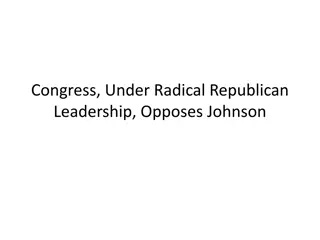The U.S. Congress Structure
The U.S. Congress comprises the Senate and the House of Representatives, each with distinct roles and composition. Senate has 2 senators per state while the House representation is based on population. Learn about vacancies, elections, redistricting, and gerrymandering affecting these legislative bodies.
Download Presentation

Please find below an Image/Link to download the presentation.
The content on the website is provided AS IS for your information and personal use only. It may not be sold, licensed, or shared on other websites without obtaining consent from the author.If you encounter any issues during the download, it is possible that the publisher has removed the file from their server.
You are allowed to download the files provided on this website for personal or commercial use, subject to the condition that they are used lawfully. All files are the property of their respective owners.
The content on the website is provided AS IS for your information and personal use only. It may not be sold, licensed, or shared on other websites without obtaining consent from the author.
E N D
Presentation Transcript
Senate: Two Senators per state regardless of population (2 x 50 = 100). Six-year terms. House of Representatives: Based on population but the Constitution guarantees each state one member. Two- year terms. Total has been 435 since 1912, capped by federal law since 1929 Seven states each have one representative California has 53 The House also includes five Delegates from Washington, DC; the territories of the Virgin Islands, Guam, American Samoa and the Northern Mariana Islands; and a Resident Commissioner from Puerto Rico (who is the only House member with a 4-yr. term) They can introduce legislation and vote in committee, but cannot vote in the full House
2010 2012 2014 2016 2018 2020 2022 House |====|====|====|====|====|====| Sen I <06====|==============|========24> Sen II <08=========|==============|===26> Sen III |==============|==============| Pres./VP<08====|=========|=========|===24>
Vacancies in the House must be filled by special election. The Constitution gives state legislatures the power to decide how vacancies in the Senate are filled for that state. In most states, the Governor has the power to appoint someone to serve until the next election.
The only time both Senate seats from the same state are up for election at the same time is if there s a vacancy. 2008: Sen. Lindsey Graham elected to 6-year term. 2010: Sen. Jim DeMint elected to 6-year term. 2013: Sen. DeMint resigns to become head of the Heritage Foundation. Gov. Haley appoints Rep. Tim Scott to serve in the Senate until the next election (Nov. 2014). Scott resigns from the House and his seat is filled by a special election (Mark Sanford returns to the House). 2014: Sen. Scott elected to a two-year term and Sen. Graham re-elected to another six-year term. 2016: Sen. Scott re-elected to a six-year term.
Redistributing the number of seats in the House following each Census (every ten years) to reflect changes in population Redistricting: Redrawing the district lines within each state so that each district is equal in population Gerrymandering: Redistricting in a particular way to benefit a specific party or group In most states, district lines are drawn by the state legislature, so it matters which party controls it and which party the Governor is Majority-minority districting: Drawing a district in which a majority of citizens or voters are members of a racial minority
Majority-Minority Districting North Carolina s 12th Congressional District, 1992-1998
District D R 77,288 174,066 195,571 88,951 200,945 222,116 168,041 160,695 194,537 190,826 190,319 63,317 210,495 Other Win D R R D R R D R R R R D R Win % 75.32% 55.72% 63.11% 74.47% 57.54% 60.96% 50.10% 53.16% 51.78% 56.99% 57.42% 79.63% 56.80% 1 2 3 4 5 6 7 8 9 254,644 128,973 114,314 259,534 148,252 142,267 168,695 137,139 171,503 144,023 141,107 247,591 160,115 6,134 9,358 0 0 0 0 0 4,446 9,650 10 11 12 13 0 0 0 0 Total 2,218,157 2,137,167 50.59% 29,588 9 R, 4 D 48.74%
District D 247,591 254,644 259,534 114,314 142,267 148,252 141,107 144,023 160,115 128,973 137,139 171,503 168,695 2,218,157 50.59% R 63,317 77,288 88,951 195,571 222,116 200,945 190,319 190,826 210,495 174,066 160,695 194,537 168,041 2,137,167 48.74% Other Win D D D R R R R R R R R R D Win % 79.63% 75.32% 74.47% 63.11% 60.96% 57.54% 57.42% 56.99% 56.80% 55.72% 53.16% 51.78% 50.10% 12 0 1 4 3 6 5 6,134 0 0 0 0 0 0 0 11 10 13 2 8 9 7 9,358 4,446 9,650 0 Total 29,588 9 R, 4 D
Sex Race/ethnicity Age Economic status Religion Education Sexual orientation What difference does this make (why do we care?)
Descriptive representation: Someone who looks like you Substantive representation: Someone who shares your policy views
Name recognition David Mayhew: Credit-claiming, advertising oneself Fundraising advantage http://www.opensecrets.org/overview/incumbs.p hp Federal spending (pork barrel) Franking (free mailing) Constituency service/casework Morris Fiorina: They deliberately make programs complicated so constituents need help with them
http://www.house.gov/committees/ http://www.senate.gov/pagelayout/committ ees/d_three_sections_with_teasers/committee s_home.htm
Personal interest Constituency needs Policy expertise Fundraising advantage Richard Fenno: Influence, re-election, policy
https://www.govtrack.us/congress/bills/stati stics https://www.youtube.com/watch?v=FFroMQ lKiag https://www.youtube.com/watch?v=JUDSeb 2zHQ0
Submission and referral S. 806, the College for All Act Sponsored by Sen. Bernie Sanders https://www.congress.gov/bill/115th- congress/senate-bill/806?r=10 Referred to the Committee on Health, Education, Labor, and Pensions: https://www.help.senate.gov/
Committee action Subcommittee referral (not always in the Senate) https://www.help.senate.gov/about/subcommittee s Committee action Hearing https://www.help.senate.gov/hearings Markup Vote and committee report to Senate
Majority Leader sets the schedule and terms of debate under a unanimous consent request http://www.gpo.gov/fdsys/pkg/CCAL-114scal- 2015-09-21/pdf/CCAL-114scal-2015-09-21.pdf Filibuster, cloture (60 Senators) https://www.congress.gov/crec/2013/09/24/CRE C-2013-09-24-pt1-PgS6699-3.pdf (p. 6732) Other ways to delay Debate in full Senate, vote
Submission and referral Committee action Subcommittee referral Hearing http://edworkforce.house.gov/news/documentsingle.aspx? DocumentID=398597 Markup, vote Full committee hearing Markup http://edworkforce.house.gov/calendar/eventsingle.aspx?E ventID=399156 Vote and committee report to House http://www.gpo.gov/fdsys/pkg/CRPT- 114hrpt46/pdf/CRPT-114hrpt46-pt1.pdf
House Rules Committee sets terms of debate http://www.gpo.gov/fdsys/pkg/BILLS- 114hres421eh/pdf/BILLS-114hres421eh.pdf Action by full House http://www.gpo.gov/fdsys/pkg/BILLS- 114hr3134eh/pdf/BILLS-114hr3134eh.pdf Conference Committee http://www.gpo.gov/fdsys/pkg/CRPT- 113hrpt564/pdf/CRPT-113hrpt564.pdf Vote on committee report by House and Senate Sent to President https://www.whitehouse.gov/the-press- office/2015/03/31/memorandum-disapproval-regarding-sj- res-8 Veto override if necessary
Authorization: A bill which gives a program the legal authority to operate Appropriations: A bill which actually spends the money for the program to operate (12 appropriations bills are supposed to be passed each year, covering different sectors of government) Continuing resolution: A catch-all spending bill which funds the government if the appropriations bills are not passed on time; otherwise, parts of the government may shut down The fiscal year starts on Oct. 1 and either the appropriations bills must be passed or a continuing resolution must be passed.
http://www.appropriations.senate.gov/news /first-six-years-senate-committee-completes- work-all-12-appropriations-bills http://appropriations.house.gov/news/docu mentsingle.aspx?DocumentID=394312 https://www.congress.gov/resources/display /content/Appropriations+for+Fiscal+Year+20 16
Delegate: There to represent the views of a majority of your district Trustee: There to exercise your own judgment regardless of public opinion Politico: Delegate or trustee depending on the issue (Note that if your views didn t coincide with a majority of the voters a majority of the time, you wouldn t have been elected in the first place)























